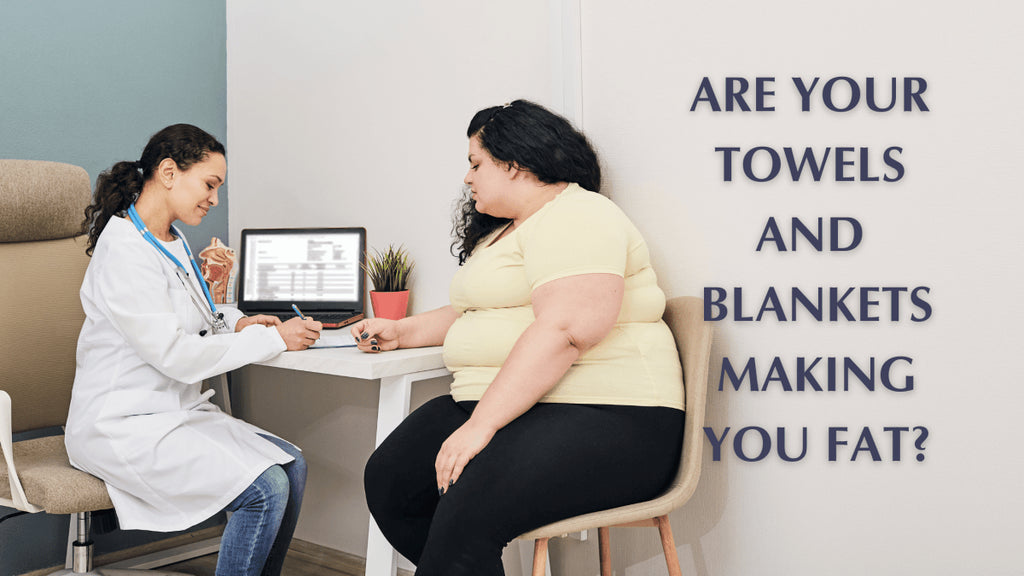Are your towels and blankets making you fat?
Posted by JEFF MACOMBER

Are Microplastics in Your Clothes and Home Textiles Contributing to Weight Gain?
The Hidden Impact of Microplastics on Metabolism
Microplastics have become a growing concern due to their widespread presence in the environment, food, and even the air we breathe. While many discussions focus on their impact on marine life and pollution, recent research suggests they could also be influencing human health—specifically contributing to weight gain and obesity. But how do microplastics from textiles, such as clothing, towels, and blankets, play a role in this issue?
How Microplastics from Textiles Enter the Body
Many household textiles, including synthetic fiber towels, blankets, and clothing, shed tiny plastic particles—microplastics—every time they are washed or worn. These microscopic fibers enter the environment and can be inhaled or ingested. Over time, these particles accumulate in the body, potentially interfering with metabolic processes.
The Link Between Microplastics and Obesity
Several studies suggest that exposure to microplastics may disrupt the body’s ability to regulate weight. Here’s what the research says:
1. Endocrine Disruption and Fat Storage
- According to a study published in WebMD, microplastics can act as endocrine disruptors, interfering with hormones that regulate metabolism and fat storage (WebMD).
- When endocrine function is disrupted, the body may be more likely to store fat, leading to weight gain.
2. Microplastics and Fat Tissue Damage
- A study in Nature found that microplastics infiltrate adipose (fat) tissue, causing premature aging, inflammation, and metabolic dysfunction (Nature).
- This suggests that exposure to microplastics may contribute to obesity-related disorders.
3. Parallels Between Plastic Production and Obesity Rates
- A Frontiers in Endocrinology review highlighted how the global rise in plastic production correlates with increasing obesity rates, suggesting a potential environmental link (Frontiers in Endocrinology).
- This reinforces concerns that everyday exposure to plastic particles—especially from textiles—may contribute to metabolic dysfunction and weight gain.
Here is a graph overlaying the introduction and adoption of plastic based textiles with the US obesity rate:

Note: this graph does show a level of correlation but not specific causation.
How to Reduce Microplastic Exposure from Textiles
While more research is needed to fully understand the relationship between microplastics and obesity, reducing exposure can be beneficial. Here are a few ways to limit your intake of microplastics:
- Choose Natural Fibers – Opt for towels, blankets, and clothing made from organic Turkish cotton, linen, hemp, and wool instead of synthetic fibers like polyester and acrylic.
- Use a Microplastic Filter – Washing machines with microplastic filters can capture synthetic fibers before they enter wastewater systems.
- Avoid Fast Fashion – Low-quality synthetic clothing sheds more microplastics; investing in durable, natural fiber textiles reduces long-term exposure.
- Air-Dry Clothes – Heat from dryers increases microplastic shedding. Line-drying reduces fiber breakdown.
Final Thoughts
The possibility that microplastics from textiles could contribute to weight gain is alarming, but by making conscious fabric choices, we can limit exposure and protect both personal health and the environment. Opting for high-quality, natural fiber textiles like Turkish cotton towels and blankets not only enhances comfort but may also reduce the risks associated with synthetic microplastics.
Looking to make the switch? Explore our premium collection of organic Turkish cotton towels and blankets today!

